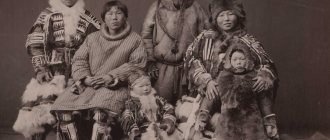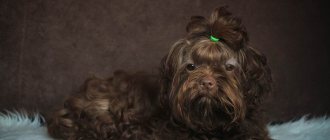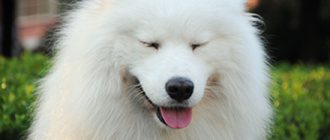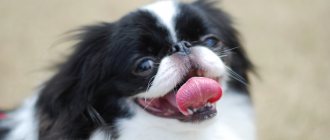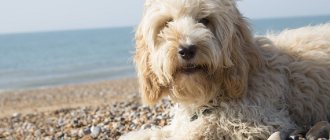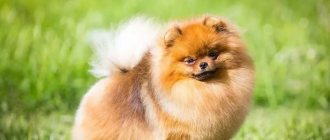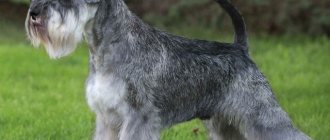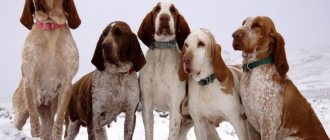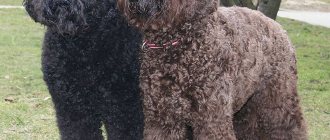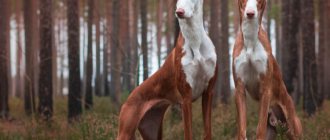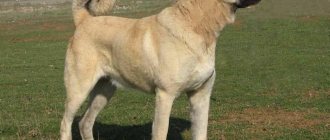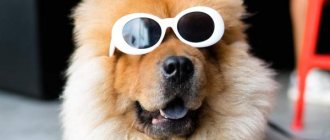Reproduction and lifespan
Inuit breeding is carried out mainly by the British and the Eskimos themselves.
There are no breeders of the breed in Russia. On the territory of the federation, the need for domestic wolves is satisfied by wolf-dogs. These are hybrids of shepherd dogs and forest predators. One variation was developed in the Kemerovo region back in Soviet times, and the other after the collapse of the Union in St. Petersburg. There are rarely more than 5 puppies in an Inuit litter. If kept properly, dogs can live up to 18 years. However, the average age is 12 years.
Health problems shorten your life. Accustomed to aboriginal living conditions, Canadian huskies are also accustomed to environmentally friendly food and clean air. Hence allergic reactions far from home and a tendency to obesity. The Inuit also suffer from joint problems. The point here is the massiveness of the dogs. The joints are strained under a 50-pound weight.
Inuit food
The Inuit in the photo looks invincible. The appearance of a wild animal is associated with power and health. However, at home, representatives of the breed are prone to obesity. This obliges not only to provide the dog with proper physical activity, but also to monitor the pet’s nutrition. Obesity leads to diseases of the cardiovascular system. Inuit are especially susceptible to them.
A combination of 50% proteins, 15% fats, 25% in the diet helps to avoid health problems. The rest comes from carbohydrates.
The optimal ratio of components in dry food for service and aboriginal dogs. But the Inuit prefer natural food.
Among grains, Canadian huskies love buckwheat, rice, and corn. Among meats, the Inuit prefer coarse meat with veins. This contains the optimal content of substances beneficial for dogs. Fatty meat is not advisable. Lenten types include veal, game, and skinless chicken. Low-fat fish is also used.
White Inuit dog
Inuit are demanding about the quality and freshness of food. It is easier to track the characteristics of natural products than dry food.
Like spaniels, Canadian huskies are prone to overeating. It is important to remember that:
- A 25 kg dog needs a 400 gram serving.
- for 36 kilos 460 grams are required
- if the dog weighs 38 kilograms, the portion is selected to be 500 grams
- A 50 kg Inuit requires 530 grams
2 feedings per day are enough. A Northern Inuit puppy eats three times a day. The Eskimo Inuit themselves feed their dogs once every 4 days. This is the type of food a wild wolf eats. As they say, not a single Canadian husky suffered from this. Dogs of this breed often suffer from excess food. Therefore, if an adult Inuit begins to gain weight, the portion size is reduced until the pet's weight stabilizes.
Content Features
Nenets Laika: an exclusive breed with great working potential
The ideal option for a Sabueso would be to live in a private house in a hunter’s family. Aviary keeping is also possible.
The Spanish Hound is an active dog with a well-developed sense of smell, physically strong and resilient. It must be provided with good exercise to maintain tone and prevent obesity, which is common in the breed. Food must be of high quality and complete. Many owners prefer to feed their dogs super-premium ready-made food. Natural supplements are supplemented with vitamins and minerals in accordance with the recommendations of the breeder or veterinarian.
The Spanish hound does not require complex care. Grooming comes down to standard procedures: combing, rare bathing, trimming nails, maintaining healthy eyes, ears and teeth.
Character
Despite the appearance of a predator, the Utonagan is a kind and affectionate dog. Loves active games, adores the family in which he lives. Suitable for both families and single people, as it knows how to adjust its behavior in accordance with the characteristics of the character and age of the owner. Very smart. An excellent companion, watchman and protector. In ordinary life he is calm and balanced and does not show any aggression.
Very energetic, during games he sometimes loses concentration and can knock down both a child and an adult. Therefore, if utonagan plays with children, the intensity of the game should be controlled. However, if a dog is deprived of the opportunity to run and jump properly, it is very sad. She doesn’t know how to be alone for a long time, she gets very bored. He begins to dig tunnels and try to free himself.
Character and behavior
What to feed a Maine Coon to grow big
The Stabyhune has a balanced, sincere disposition without excessive excitability or aggression. He is smart, sociable and inquisitive. Cannot stay alone for long periods of time. Energetic and active, especially when it comes to walking. Always ready to support the company and any undertaking, be it jogging in the forest, training, or just playing in the yard. The rest of the time, calm and patient. He is very gentle and loving towards his family. Gets along well with children, given appropriate upbringing. Loyal to livestock and poultry. Gets along well with other animals.
The Stabihund is quite independent, which can make it seem stubborn. He is quite trainable, but to raise an obedient working dog you will have to spend a lot of time and patience. It is advisable that the owner has experience in keeping hunting breeds. Stabyhunes are vigilant watchmen and often bark at the slightest noise. They will try to scare off the ill-wisher, but they are unlikely to bite.
Where to keep
Representatives of the breed are excellent guards; it is best to keep them outside the city, in the courtyard of a private house. Life on the street is more comfortable for Utonagans, since the wool with a dense double undercoat prevents it from freezing or getting wet. This is a very healthy breed that is not prone to disease. The dog has an excellent appetite, which is why it can overeat and gain weight. This needs to be carefully monitored, given as much food as it should be, and also be sure to give the dog the opportunity to exercise a lot.
Pomsky
What to feed a Maine Coon cat to grow big
A Pomsky is a cross between a Husky and a Pomeranian. The breed appeared in the USA in 2013, but has already acquired loyal fans in many countries. The external characteristics of representatives of this breed are not constant and depend on the combination of genes.
There are five main conformation types: fox type, white Pomsky, plush husky, brown blue-eyed and short-haired type. Pomskies are decorative and designer dogs; their photos are often published on social media feeds.
Fluffy handsome guys love attention and willingly pose for cameras
By nature they are curious, playful, good-natured and flexible. Pomskies do not lack the adventurous touch inherent in huskies, so on walks the owner should carefully keep an eye on the pet, which is constantly looking for adventure.
Utonagan - appearance of a wolf, spirit of a dog
History of the breed.
Among several breeds of so-called wolf dogs, there is one that is in no way related to the famous predator. In the 80s of the XX century. British, American and Canadian dog handlers decided to create a purely domestic dog, which would only look like a wolf in appearance. Siberian Husky and German Shepherd were selected for selection . This creative project was headed by Edwin Harrison. But the founder of the breed was a completely purebred Malamute named Dollar, who has an exceptional appearance. From each of his offspring, experts selected the best representatives with the greatest number of required external features. In order to advertise the new original breed of “wolf dog” and attract potential owners to it, the breeders decided to play on the name. For this, linguists were involved, who found an ancient word from the language of the Chinook tribe, meaning “wolf spirit.” In other words, utonagan.
From this moment on, many people buy beautiful puppies, and Utonagans gradually and confidently gain popularity. In 1996, the first club called “Northern Inuit” was created. But in the process of development, the breed is divided into two branches, the representatives of which are very similar, but still have differences. And now, since 1999, there are already two clubs - “Northern Inuit” and “Northern Inuit of Great Britain” (in 2002 it was renamed “Utonagan”). Today, these are the only organizations involved in the development and improvement of their officially unrecognized creation.
Appearance, care and maintenance.
As stated earlier, Utonagans only have a superficial resemblance to wolves. In general, beautiful fluffy animals about 70 cm tall and weighing up to 50 kg are preferably kept in country houses outside (in insulated booths) and serve as good house guards for their owners. Although, if you look from the outside, the disposition of such guards is quite flexible and good-natured. Therefore, representatives of this breed can often be seen next to blind people as guide dogs or in various rehabilitation centers.
If the “wolf dog” lives in an apartment (which is also acceptable), then it needs long and active walks. It is also recommended to involve your pet in various training programs and dog sports.
Like their ancestors, Utonagans take care of themselves independently, so they do not require much effort from their owners. Although, of course, the fur should be periodically combed and the pet should be regularly taken to the veterinarian for examinations and consultations on creating a feeding menu (for each it is formed mainly individually, depending on the predominant blood).
All the best, see you again friends! If the post was useful to you, please share it on your social network. Click on the buttons below the article. You don't care, but I'm pleased. Sincerely, blog author Marina.
Description and characteristics of the Inuit
The Northern Inuit is otherwise called the Canadian Husky. It is in Canada that the majority of Eskimo Inuit live. It was in Canada that work was carried out on crossing the German Shepherd, Alaskan Malamute, Siberian Husky and the aboriginal Inuit Eskimo dog.
Selection began in the 80s of the last century. At the same time, there is a version that Labradors took part in the breeding of the breed instead of shepherd dogs.
The purpose of the experiments was to breed a domestic wolf. Dogs of the breed look like a wild animal, but do not carry its fresh genes. It's possible. There are several species of wolfdogs in the world. Crossbreeding between dogs and grays is possible. The offspring does not lose the ability to reproduce. However, wolf genes make dogs timid and difficult to train. Inuit are ideal companions.
Northern Inuit are used as sled dogs
The Utonagan also descended from the aboriginal Inuit dog. These dogs are sled dogs. However, the differences in appearance between the Utonagan and the Inuit are vague. The external characteristics of each breed are also vague. It's not just about youth.
Most canine associations condemn the creation of hybrids, that is, the crossing of several already formed species. The Inuit remain unrecognized. This partly frees up the hands of breeders who continue to experiment with the appearance of dogs.
The unofficial Inuit standard is:
The head is wedge-shaped and dry, with a low and flat forehead, the transition from which to the nose is moderately developed. The nose itself is straight, half the length of the head. The lips are of medium thickness and tightly compressed. This is partly facilitated by the tone of the chewing muscles and a correct, full bite.
Developed eye sockets do not look heavy and are characterized by an average filling of the space under them. The eyes themselves are almond-shaped and slanted. Triangular ears are located on top of the head. They are planted at an average distance from each other.
The body of the Inuit is rectangular. Bitches are longer than males. The line of the back rises smoothly from the croup to the withers. The loin is moderately arched. The Inuit's groins are tucked up, and the sternum is of medium width and extends towards the tail. The last one is woolly, attached at the level of the back. The tail is straight and hangs calmly.
The Inuit's height and weight are "vague". Weight ranges from 25-50 kilograms. The height of dogs of the breed reaches 76 centimeters at the withers. The bottom bar is 59 centimeters.
The wool is two-layer. The awn is tough. The undercoat is soft and dense. The Inuit fur coat is colored sable, white or black. The last two colors must be unmarked.
The requirement for a white mask on the face, like that of wolves, is losing relevance. At the initial stage of the formation of the breed, only white Inuit did not have a mask. More precisely, the mark was not noticeable. Now Inuits without masks are also recognized.
Dogs are recognized by amateur clubs. There is one, for example, in England. Having been bred in America, the breed gained popularity in Foggy Albion. It was here that an association of Inuit lovers was founded, they monitor their standard, and hold exhibitions.
Origin story
The history of the Utonagan breed began in the 80s of the 20th century, when several breeders from Great Britain set themselves the goal of breeding dogs that looked like a wolf. The result of painstaking work was a new breed - the Northern Inuit dog. Subsequently, disagreements arose between the breeders regarding the path of development of the breed and they were divided into small groups. Thus, the northern Inuit dogs gave rise to offshoot breed groups, including the Utonagan, Tamaskan, and British Timber Dog.
Utonagan is the result of crossing three breeds: Alaskan Malamute, German Shepherd, Siberian Husky.
To consolidate the desired qualities and expand the gene pool, Utonagan breeders began an outcrossing program in 2009 (reintroducing the blood of the founding breeds). The results were excellent both in terms of health and temperament.
Description of the breed
The Utonagan is unique in that it resembles a wolf more than other dog breeds. However, its size and power are still inferior to those of a wolf. Edwin Harrison is considered to be the person who developed this breed; he did a lot to popularize it. The first representative of the breed was called Dollar, his offspring were very reminiscent of small wolf cubs. Utonagans are bred from matching German Shepherd, Alaskan Malamute and Husky puppies.
The breed instantly became popular, but over time it divided into two directions, which turned into independent breeds: the northern Inuit dog and, in fact, the Utonagan. The breeds are similar, but they are bred separately. Utonagan is most popular in its historical homeland - Great Britain, but has not yet received recognition from the International Cynological Federation. However, since the end of the last century, a number of breed clubs have appeared, it has a lot of fans, and their number is growing, and it is possible that recognition at the world level is a matter of time.
Character and behavior
The Spanish Hound is an affectionate dog with a calm and noticeably independent temperament. Smart, sensitive and understanding. With proper upbringing, he grows up to be very sociable and responsive, focuses on the owner and tries to please him. Relatively easy to learn. Requires good socialization, especially if he lives in the city. Can be a wonderful family dog and companion, but will only be happy with someone who can develop her natural potential as a hunter.
The energetic Spanish Hound often enjoys playing with children. But he will not tolerate cruel or disrespectful treatment of himself. She gets along with the animals she grew up with. Usually not aggressive with other dogs. Can work in pairs or a small pack of hounds. The guard instinct is expressed. There is no security guard. The dog is cautious or friendly with strangers, not aggressive. When hunting, she is able to show courage and courage.
Features of wolfdogs
Wolf dogs are powerful, beautiful, extremely intelligent and highly intelligent animals.
Positive behavioral characteristics and character traits include the following:
- High level of mental abilities, and, as a result, good learning ability. Animals are smart, quickly and correctly grasp the meaning of commands. It is recommended to involve professional dog handlers with extensive experience working with service dogs in training and education.
- Excellent performance characteristics - the instinct inherited from the “wild” ancestor allows you to brilliantly perform a variety of search, investigative and security tasks.
- Devotion, obedience - with a properly constructed education system. Mixed breeds must be included in the hierarchical human-dog social system from birth. In this case, problems with discipline and submission to the owner will not arise.
- Unpretentiousness in food, the ability to go without food for a long time, the absence of special conditions for keeping a wolf-dog. The best option is an open space with the possibility of free walking. As a place to rest and sleep, a spacious enclosure with an insulated floor is enough to provide shelter from heavy rain, piercing winds and severe frost. The enclosure or canopy must be located away from drafts and direct sunlight.
- There are no special requirements for caring for the wolf-dog. So, the coat is combed once a month, and to maintain cleanliness it is enough to bathe your pet only 2 times a year. Other procedures, such as cleaning the eyes, ears, and examining the teeth, are carried out once every 7-10 days. Wolfdogs' claws usually do not require trimming, as they wear down naturally.
- Excellent health. For example, it is noted that wolf dogs are not susceptible to many diseases characteristic of large dogs - joint dysplasia, diseases of the digestive system. Representatives of this breed are considered long-livers - life expectancy often exceeds 20 years.
But these animals also have unfavorable traits that the future owner must keep in mind:
Animals have a pronounced desire for dominance. For this reason, they are absolutely not suitable for people with a soft, pliable character.
The feeling of belonging to the “pack” is preserved in this type of dog for a very long time, and it is important for wolf-dogs to have a leader to whom they obey unquestioningly. The owner's leadership qualities are the key to a successful relationship with the pet.
It is not recommended to have a wolf-dog for inexperienced owners who do not have experience in communicating, raising and training large service-class dogs. Not suitable for keeping in an apartment (only real wolf-dogs are not suitable).
It is forbidden to put wolfdogs on a chain
This often leads to aggression, including towards the owner and members of his family.
They do not get along very well with other animals.
Care and maintenance of an Inuit
The Inuit is a stellar breed. Without being officially recognized, Canadian Huskies are invited to film films. In particular, the Inuit appear in the acclaimed series “Game of Thrones”. There, Canadian huskies play wolves. Filming real people is risky and illogical. You won't get the script done properly from savages. The Inuit play by the rules and are obedient.
Representatives of the breed have no difficulty in filming outdoors and withstanding the vagaries of the weather. A thick undercoat helps. Due to it, dogs are comfortable being kept on the street. The dimensions of the Inuit also speak in its favor. Most of them are large.
Inuits are a very intelligent and easy to train breed of dog.
In order to maintain muscle tone, which affects the health and development of dogs, you need to walk them a lot and play actively. In the yard, a spacious enclosure, it is easier to satisfy the need.
Otherwise, the Inuit are unpretentious:
- Once a month, dogs have their nails trimmed and their ears checked for cleanliness.
- It is advisable to brush your teeth once a day. Few owners fulfill the norm. Therefore, most people have to remove already formed tartar in veterinary clinics. If it is not removed, the teeth become loose, fall out, and rot.
- It is advisable to comb the Inuit once a week.
- Representatives of the breed are bathed every 2-3 months.
The rules are standard for most breeds. By the way, Canadian huskies do not get along well with representatives of other breeds in the same territory, trying to dominate. Some Inuit try to do this in a group of people. Firm, but not cruel, parenting is required. The stubborn nature of the Canadian husky will have to be tamed.
Stubbornness in the Inuit character is combined with intelligence, intelligence and even ingenuity. The dog becomes a good friend to a professional breeder, but may not find a common language with a beginner.
Fresh air and good ecological terrain are important to the Inuit
Kinds
Inuit is a dog classified as a Spitz. These include breeds of a primitive type, close to aboriginal ones.
The breed has no subspecies. However, due to the lack of a clear standard, the Utonagans are classified as Inuit. Their difference is considered to be their smaller size. Utonagans are shorter than 59 centimeters at the withers.
Utonagan dogs are often classified as Inuit.
Inuit are also divided by color. In particular, the sable pattern is acceptable in all variations, even on a white background. The sable's coat is distinguished by darkening along the back and face. The sides and bottom of the paws are often highlighted. The main tone can be peach, brown, almost black. The transitions between color fragments are smooth. There are no clear spots.
Appearance
The Norwegian Lundhund is a small Spitz-shaped dog with a slightly elongated format. Sexual dimorphism is pronounced.
- height at the withers of males - 35-38 cm, weight - about 7 kg;
- height at the withers of females is 32-35 cm, weight is about 6 kg.
Upon closer examination, it becomes obvious that the Norwegian Lundehund has unique anatomical features:
- Thanks to its very mobile neck, the Lundehund can throw back its head so that its nose touches its back;
- All joints of the forelimbs are extremely mobile;
- The pupil of the golden eyes is surrounded by a dark rim;
- The ear cartilage is able to retract and fold, tightly closing the ear canal.
- The front feet are slightly turned outward and have at least 6 toes, 5 of which rest on the ground. The inner fingers have a common system of ligaments and muscles. There are 8 pads, not 5;
- The hind foot is also equipped with 2 extra toes and 7 pads.
All these features allow Lundehunds to be real climbers, capable of climbing rocks, climbing into narrow crevices of caves and winding burrows of dead ends.
The head is of medium width, clear lines. The skull is slightly round. Stop is expressed. The muzzle is of medium length, wedge-shaped with a slightly convex bridge of the nose. Scissor bite. The eyes are set slightly obliquely, not protruding, yellowish-brown in color. The ears are triangular, wide at the base, erect, very mobile. The neck is of medium length, strong, with a noticeable collar.
The case has a slightly stretched format. The topline is straight. The croup is slightly sloping. The chest is of medium width, quite deep, spacious. The abdomen is moderately tucked. The tail is set moderately high, of medium length, well covered with hair, carried in a ring or carried downwards. The forelimbs are straight with moderate angulations. The hindquarters are set rather narrowly, strong and muscular. The paws are oval, slightly turned outward.
The coat consists of dense and rather coarse guard hair and soft undercoat. The hair on the head and the front side of the limbs is short. Longer on the neck, back of the hind legs and tail. The color is always in combination with white, from fawn to red with more or less blackened tips of the hair.
Parameters of the Garafian Shepherd's appearance
- The head
is wedge-shaped. The skull is flat, gradually tapering from the sides to the nose. The frontal part is not wide. Cheekbones are flat. The eyebrows are developed harmoniously. - The muzzle
is long, but not narrow, slightly widened at the base. The stop is obvious, but smooth. - The nose
is developed, rounded, black. - The eyes
of the Garafian Shepherd are located just above the stop, round in shape. Their color is light brown with an amber tint. - The ears
are at the level of the back of the head, triangular, erect, mobile. - The neck
is medium-sized, high-set, strong, dry, beautifully arched. The withers are developed. - The body
is rectangular, strong, muscular. The chest is oval. The back is straight and long. The lower back is strong. The croup is voluminous, slightly sloping. The bottom line is moderately tucked. - The tail
is set high. The natural size is long, curved in the shape of a sickle. - The front legs
are stable and strong with prominent muscles. The hindquarters are parallel to one another with strong bones. The thighs have voluminous muscles. - The paws
are compact, the toes are tightly connected. - The coat of
the Garafian Shepherd is thick, fluffy, and not uniform in length. The guard hair is smooth and slightly wavy in some areas, moderately hard. The undercoat is dense and soft. Short hair on the muzzle, frontal area, back of the front legs, and on the hind legs from hips to paws. The medium length coat grows along the top of the body and on the tips of the ears. Decorating fur along the bottom of the ears, on the cheekbones, on the neck, along the lower abdomen, on the hips, front legs and on the tail. - Color
- golden, fawn, red, red-brown and other shades of orange-red.
Interesting Facts
- The Appenzeller brand is very popular in Switzerland. Without thinking twice, she also named a breed of chicken and cheese. Therefore, the prefix “Sennenhund” is very useful if you are looking for a dog.
- The Swiss Appenzeller is the only Sennenhund that, according to the standard, is allowed not only black, but also chocolate color as its base color. In this case, the undercoat is allowed to be gray, fawn or standard black.
- The Appenzeller Mountain Dog is distinguished by its incorruptibility. Under no circumstances will a dog take a treat from someone else's hands. You can be sure that with such a security guard you will be safe.
Description of utonagan
The breed is in its formation stage, and while its main principle - resemblance to a wolf - is interpreted differently by breeders. A breed standard is also under development, some positions of which have not yet been finalized.
Appearance
The spirit of the wolf has found its absolute embodiment in the appearance of the new breed: the utonagan is indeed very similar to a wild predator, but still it is some kind of cartoonish, lightweight version of the wolf. It is noticeably inferior to its standard in terms of build power, bone volume and head volume.
Accordingly, the dimensions of a wolf dog are not so impressive. With a respectable height (up to 73 cm at the withers in males and up to 66 cm in females), the weight of the utonagan is relatively small - for different breed types it can range from 25 to 50 kg.
We recommend reading: What is in store for EQUITANA 2017 - the main exhibition in Europe
Yes, he looks like a wolf, but like some kind of not very real one - a fairy tale one
Acceptable breed colors:
- pure white;
- creamy;
- silver gray;
- wolfish;
- brown;
- black.
New color variants are appearing in the breed, and the experimental standard currently regulates them loosely. Regardless of the main color of the coat, there should be a characteristic wolf “mask” on the face, and there may be white spots on the chest, but not too large. The darkest coat is on the back, and on the belly, neck and feathers the fur can be noticeably lighter.
Photo gallery: some colors of Utonogan
Wolf color is the most natural and common in the breed Light shades of wolf color look more elegant than dark ones Black utonagan looks mystical Warm creamy, golden and red shades of fur suit the “good wolf” very much
An important role in the exterior should be played by the characteristic shape of the head (now it is smaller and more graceful than that of a wolf), the location and color of the eyes (preference is given to amber shades of the iris, although the standard has not yet finally decided on this issue)
The fur of the Utonagans also attracts attention - it is not wolf-like at first glance: the fur of the representatives of the young breed is longer, thicker and looks much more impressive. In winter, the undercoat becomes much more abundant than in summer.
Utonagan's movements are graceful and perfect
Character and behavior
Utonagans are temperamental and playful; adult dogs retain their cheerful puppy disposition. If they do not receive enough attention from the owner, they begin to get bored and become mischievous from idleness. Some dogs of this breed can howl and “sing” out of nothing to do, which shocks impressionable neighbors.
They adore the owner and his family, are very affectionate and try with all their might to earn praise. They are friends with children and willingly play, but they should not be left alone with children - after playing, the dog does not feel its size, does not calculate its strength and can push the child. They get along well with domestic animals, especially dogs of any breed.
Health
Strong immunity and good health are the undoubted advantages of utonagans. Dogs rarely get sick, their average life expectancy is 14–15 years, and on English-language forums you can also find information about pets who have celebrated their twentieth anniversary - this is an enviable age for large dogs.
Unfortunately, typical diseases received mainly from northern ancestors also make themselves felt; we need to highlight the following:
- hip dysplasia;
- epilepsy;
- Addison's disease (chronic adrenal insufficiency);
- von Willebrand-Diana disease (a hereditary blood disease characterized by the occurrence of episodic spontaneous bleeding);
- various eye problems.
Advantages and disadvantages
Every breed has its own advantages and disadvantages, and the Utonagan is no exception. Evaluate them in relation to your lifestyle and preferences to see if this special wolf dog is right for you.
Table: pros and cons of utonagan
| Advantages of the breed | Disadvantages of the breed |
|
|
We recommend reading: Subcutaneous mites in cats: recognize, eliminate, prevent
If you are ready, welcome this dog into your home and your heart.
Exterior
The weight of an adult dog ranges from 25 to 50 kg, the male reaches 73 cm in height, the female – 66. The color is pure white, creamy, silver-gray, wolf, brown, black. Any color is characterized by a “wolf mask” on the face. There is no definitive standard for color yet. There may be a white edging on the chest.
The muzzle strongly resembles that of a wolf. The ears are set high, large, erect. Eye color has not yet been determined, but amber or honey-yellow are more common. The shape and location of the eyes are very similar to those of a wolf.
The body is elongated and flexible. The shape of the chest resembles a pear. The back is straight, the stomach is sunken on the sides. The legs are straight and strong. In summer, the thickness and length of the coat changes, as does the thickness of the undercoat.
Origin story
The history of the Utonagan breed began in the 80s of the 20th century, when several breeders from Great Britain set themselves the goal of breeding dogs that looked like a wolf. The result of painstaking work was a new breed - the Northern Inuit dog. Subsequently, disagreements arose between the breeders regarding the path of development of the breed and they were divided into small groups. Thus, the northern Inuit dogs gave rise to offshoot breed groups, including the Utonagan, Tamaskan, and British Timber Dog.
Utonagan is the result of crossing three breeds: Alaskan Malamute, German Shepherd, Siberian Husky.
To consolidate the desired qualities and expand the gene pool, Utonagan breeders began an outcrossing program in 2009 (reintroducing the blood of the founding breeds). The results were excellent both in terms of health and temperament.
Price when buying a Utonagan puppy
Unfortunately, the breed is only gaining momentum in its development. Therefore, as such, Utonagan kennels have not yet been registered in Russia; there are only the first modest experimental attempts by breeders to breed these dogs from representatives of the breed imported directly from Great Britain. The lack of official recognition of these dogs also contributes. It is difficult and economically unprofitable for dog breeders to breed animals with an uncertain status and a complete lack of breed standards. Nobody wants to grow someone unknown.
For this reason, purchasing a dog-wolf in Russia is problematic; you can easily run into scammers who will sell you a husky or malamute mix, or even a completely mongrel “nobleman” under the guise of a scarce and expensive utonagan for a lot of money.
Based on the above, we can conclude that it is best to buy a dog-wolf puppy now directly in its home territory - in the UK. There, the price of a Utonagan puppy, depending on its size, gender and color, will cost from 600 pounds sterling (approximately 780 US dollars) and more. But on the other hand, you will be completely sure of the origin of your pet and will be able to receive the necessary professional advice on its maintenance.
For more educational information about utonagan, watch this video:
Price
The price of an Inuit starts from 50 thousand rubles. It's £500. It is in this currency that the price is usually negotiated, since puppies are ordered from the UK. There are more people willing to buy a Canadian Laika within the country than there are Inuit themselves. Therefore, clients sign up for a queue.
After waiting for the puppy, all that remains is to transport it to the owners. Transportation in Russia is an additional expense. In order not to take the dog to Europe for mating, it is advisable to purchase two unrelated Inuit.
Mixed Malamute and Shepherd. Let's see!
According to its haplogroup (genetic code), the Alaskan Malamute is closer to wolves than a husky, and even more so a German shepherd.
Malamute and Shepherd mix
The proximity of wolf blood makes this dog of great physical strength and fantastic endurance unsafe for people if not properly raised. Lack of physical activity with the Malamute’s increased need for active movement can result in unmotivated aggression, which brings the Malamute to 6th place in the list of aggressive breeds.
A socially adapted malamute retains only a wolf-like appearance, and its character becomes affectionate and good-natured. The only negative trait is animal stubbornness.
They tried to overcome stubbornness by hybridizing a Malamute with a German Shepherd. The breed qualities of both dogs were mixed in arbitrary proportions, making the cross between a shepherd and malamute unstable. Some of the puppies became efficient, like a shepherd dog, but acquired increased malice and distrust of strangers. The other part “strengthened” its stubbornness and borrowed the increased aggressive qualities of its wolf-shepherd ancestors.
Content Features
The Utonagan is a very energetic and resilient dog. Perfect for people who lead an active lifestyle. Like the parent breeds, it requires regular walks or free time to run around in a well-fenced yard. Lack of exercise leads to the development of behavioral problems. Suitable for indoor and outdoor use.
Although the utonagan looks like a wolf, it definitely does not intend to hunt for prey. Like other dogs, he needs a balanced diet in the form of natural food or ready-made industrial food.
Moderate shedding occurs almost all year round, and is abundant in autumn and spring. Caring for your dog includes standard hygiene procedures as needed.
Features of care. How to educate
It is best to get this dog for people, firstly, living in northern latitudes, and secondly, leading an active lifestyle - hunting, fishing, hiking, expeditions. It is for such people that utonagan will become an ideal companion in all endeavors.
Only a person who is stronger in spirit and strong-willed will allow himself to control himself. A man without a “core” cannot handle a dog-wolf; he will not obey him. Since one of the Utonagan’s ancestors is a German Shepherd, he is highly trainable, savvy, and trainable.
The Utonagan's coat requires frequent and thorough combing, but there is no frequent need for bathing. Physical activity is required, as are long walks.
